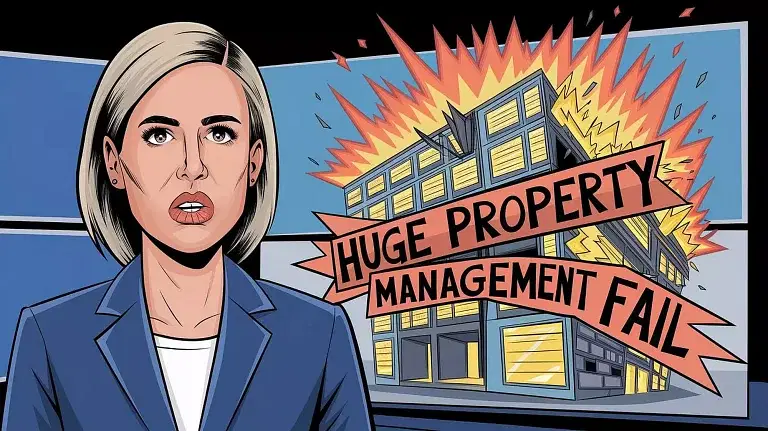As an SF Eastbay property owner, you’ve likely noticed the shifting sands of California’s insurance market. The Golden State’s homeowners insurance battle continues, and recent developments have rental property owners across the East Bay scratching their heads. At SLPM Property Management, we’re here to help you navigate these muddy waters with a steady hand and a dash of that Oakland and Eastbay grit.
The Insurance Exodus
Let’s start with the giant flatulent elephant in the room: major insurers are pulling back from California – toot sweet. Since 2022, seven of the state’s largest property insurers, including big household names like State Farm, Allstate, and Nationwide, have either dropped or limited coverage for homeowners. It’s enough to make you wonder if insurance companies think California is entirely made of dry kindling and smelly oily rags.
But wait, there’s more! Liberty Mutual recently announced it’s discontinuing a certain type of fire insurance in the state, affecting around 17,000 customers. This “dwelling” fire insurance, which covers the structure but not the contents of a home, is particularly popular among owners of rental properties and vacation homes. If you’re an San Francisco East Bay property owner relying on this type of coverage, you might be feeling a bit like a house of cards built on top the Altamont Pass about now.
The Commissioner’s Gambit

Enter California Insurance Commissioner Ricardo Lara, stage left. He’s proposing a shake-up of the insurance rules that would make even the most seasoned SF Bay politician blow an eyebrow twitch muscle. The brilliant plan? To allow insurers to use “forward-looking catastrophe models” in setting their rates, but only if they commit to writing more policies in high-risk areas.
It’s a bit like telling a picky eater they can have dessert (or pudding) but only if they eat their vegetables (or beets) first. The good news is insurance companies still get to use their new fancy-pants models to calculate risk (and unfortunately raise our rates), but they have to provide more coverage in areas they’ve been scrupulously avoiding.
The Modeling Conundrum
Now, you might be wondering what these “forward-looking catastrophe models” are all about. Essentially, they’re complex algorithms designed to predict future risks, taking into account factors like climate change predictions and historical wildfire patterns. That’s quite a bit of a jump from our current insurance pricing system, which bases homeowners insurance rates solely on verified historical data from the previous 20 years.
On paper, it all sounds somewhat reasonable. After all, we’re living in a world where the past isn’t always the best predictor of the future. (If it were, we’d still be building Blockbuster Video stores and brand new indoor shopping malls.) But here comes that “one weird trick” that consumers hate: these models are developed by undisclosed third-party companies and are considered proprietary (read secret hush hush) information. That doesn’t sound “like a good neighbor” or being in any way consumer friendly if you ask us.

Consumer advocates are also understandably concerned. Carmen Balber, executive director of Consumer Watchdog, warns that this could lead to higher rates with little benefit to consumers. She points out that under the proposal, insurance companies would have up to three years to fulfill their promise of more coverage. Add to that, there would be no penalties if insurance companies thumb their noses at the state and don’t deliver. It’s a bit like promising your spouse you are going to clean the gutters … someday on or about the tenth of never o’clock.
The Upside (Down)
But it’s not all doom and gloom filled with even stranger things. Some industry analysts do see a potential silver lining. They argue that bringing more insurance providers back to the market could potentially lead to more competitive pricing for consumers. It’s a long-term view that requires some serious optimism – and perhaps an extra thick pair of rose-colored glasses.
The basic idea is that as more insurers enter the market, competition will increase, driving insurance prices down. That’s good old-fashioned Economics 101, but applied here in California it’s like trying to play checkers onboard a fast moving roller coaster—for every smart move you make, the game can suddenly shift wildly and dramatically.
What This Means for Bay Area Rental Property Owners
So, what does all this mean for you, the stoic SF Eastbay rental property owner? Well, it’s complicated. (Isn’t everything in California?)
On one hand, these changes could potentially increase insurance availability in high-risk areas. If you own rental property in the hills of San Leandro, Castro Valley, Pleasanton or Oakland (all of which have fire-prone areas) you might find it easier to get property insurance coverage in the future. That’s good news if you’ve been relying on the FAIR Plan, California’s insurer of last resort, which has been growing faster than a line at Fentons Creamery on a hot summer’s day.
On the other hand, there’s a real possibility that rates could actually increase. The new catastrophe models might paint an overly grimmer picture of future risks, leading to higher premiums. It’s a bit like getting a somewhat, mostly accurate 20 year earthquake forecast – so yeah, sometimes ignorance is bliss.
The Silver Lining for Bay Area Rental Owners
But here’s where things get interesting for Oakland and Eastbay rental property owners. The proposed regulations also require insurers to take into account wildfire mitigation efforts when setting rates. This includes measures taken at the property, community, and landscape levels.
What does this mean in practical or useful terms? If you’ve invested in making your property more fire-resistant – things like clearing brush, installing fire-resistant roofing, or upgrading to ember-resistant vents – these efforts could potentially be reflected in lower homeowners insurance rates. It’s a bit like getting a discount for eating your vegetables after all.
Moreover, community-wide efforts could also play a role. If San Francisco East Bay cities or Alameda County decides to invest in wildfire prevention and mitigation, it could potentially benefit ALL property owners in that area. It’s a rare instance of “we’re all in this together” that for once actually rings true.
The Rocky Road Ahead
As we wait for these changes, it’s evident that California’s insurance industry is about to undergo a serious tectonic shift. The public hearing on these proposed changes is scheduled for September 17, 2024, and Insurance Commissioner Lara has expressed a desire to approve these rule changes by the end of the year.
For Oakland, San Leandro and East Bay rental property owners, this means staying informed and being proactive. Here are a few steps you can take:
- Review your current insurance coverage. Make sure you understand what’s covered and what’s not.
- Consider investing in wildfire mitigation measures for your property. Not only could it potentially lower your insurance rates in the future, but it’s also just good sense in our fire-prone state.
- Stay informed about community-wide mitigation efforts. Support initiatives that could benefit all property owners in the area.
- Keep an eye on the insurance market. As changes roll out, new opportunities (or challenges) may arise.
- Consider working with a property management company that stays on top of these issues. (Hint, hint.)
At SLPM Property Management, we’re committed to helping Oakland and Eastbay rental property owners navigate these changes. We understand the unique challenges of managing property in the SF East Bay, from the vagaries of the insurance market to the quirks of local San Francisco Bay Area rental regulations.
We’re here to help you make sense of these changes, protect your investment, and maybe even find a silver lining in all this regulatory cloud cover. Because let’s face it, in Northern California property management, you need a partner who can weather any storm – or occasional apocalyptic wildfire.
So, if you’re feeling overwhelmed by all these changes, or if you just want to ensure your property is in good hands, why not get in touch? We’re offering FREE Property Management Quotes to help you understand how professional property management can make your life easier.
After all, in a world where insurance companies are playing hard to get, wouldn’t it be nice to have someone on your side who’s always there for you? That’s what we do at SLPM Property Management. We’re here for Oakland and Eastbay rental property owners, come hell, high water, or new and “improved” insurance regulations.
Don’t let the changing insurance landscape catch you off guard. Contact SLPM Property Management today for your free quote. Because in the world of San Francisco Bay Area property management, knowledge isn’t just power – it’s peace of mind.





